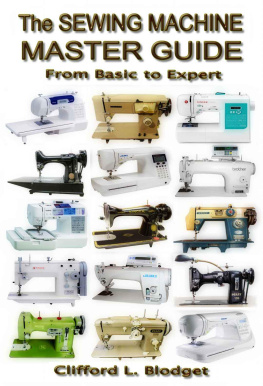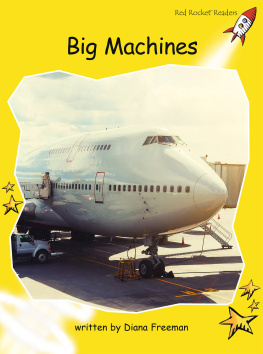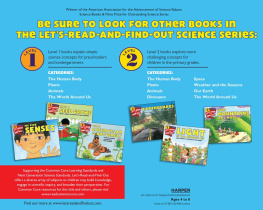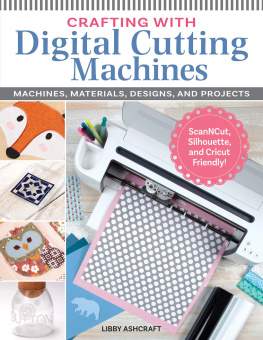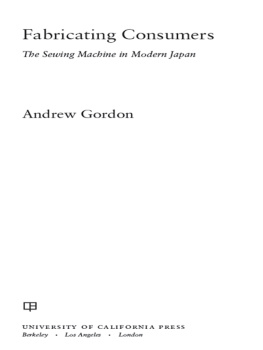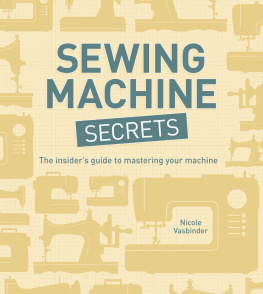Table of Contents
Title and Copyright
The Sewing Machine Master Guide
From Basic to Expert
Copyright 2013 by Clifford L Blodget
Kindle Edition ISBN 978-0-9900227-0-1
Published 2013 by Blodget Publishing, LLC.
blodgetpublishing@gmail.com
All rights reserved.
Amazon Kindle Edition - This e-book is licensed for your personal enjoyment only. This e-book may not be re-sold or given away to other people. If you would like to share this book with another person, please purchase an additional copy for each person. Thank you for respecting the hard work of this author.
All Editions - No part of this publication may be copied, reproduced, stored in a retrieval system (digital or otherwise), or transmitted in any form or by any means, electronic, optical, mechanical, photocopying, audio, video, recording, or otherwise without prior written permission.
Dedication
This book is dedicated to my parents whose support I will always be grateful for.
Introduction
I hope you will think of this book as your sewing machine companion. While writing the book I enjoyed many hours of conversation with all types of people that use sewing machines in their daily lives, both at work and at home. Many ideas for the book grew from these conversations. Whether you are a hobbyist or professional, may you have as much enjoyment as I have with sewing, sewing machines and the people you meet and spend time with in this exciting field.
How to use this Book
Beginners should read through the first few chapters to learn the fundamentals before venturing further into the book. Experts can use this as a reference book and go directly to the sections of interest. Most chapters start with basic information, more advanced information is presented as the chapter progresses. Completing every chapter is not necessary, you can read as far as you like and come back later if a deeper understanding is desired.
About this Book
This is the most comprehensive book about sewing machines available, yet is easy to navigate and understand. From basics to expert, it's two books in one, an efficient sewing machine guide and in-depth reference book that can stay with you for years to come. Starting with introductory chapters on how to use a sewing machine, the book quickly progresses to in-depth coverage of advanced subjects. Both home machines and industrial machines are covered with sections dedicated to modern machines and vintage machines. Chapters on fabric, thread, stitches, needles, feet and setting up a sewing room will help unlock your creativity.
From straight stitch machines to electronic machines over 100 of the most popular home and industrial machines are featured with insights on capabilities for each type of machine. Older machines can have a service life of 80 years or more and are better suited for some types of work. For other applications a modern electronic machine with the latest features may be needed. The chapter on buying recommendations will help you figure out what type of machine and features are best suited for your type of sewing.
Most people have a love/hate relationship with their sewing machines. They love them when the machine is working good, but hate them when frustrating problems arise. This book will empower you to eliminate the hate part of the relationship and put you in control of your machine. In-depth chapters on adjusting tension, troubleshooting and maintenance will help you handle most problems with ease and to know which problems not to tackle.
For sergers check out our companion book "The Serger & Overlock Master Guide".
The Sewing Machine Master Guide was written as both an eBook and print book using optimized reflowable formatting for a perfect presentation on small or large devices. Everything from a basic eBook reader or Kindle to a large screen PC or Mac is supported.
Why the low price? Electronic publishing and print-on-demand is used with distribution to more than 80 countries worldwide. The pricing reflects this new technology and distribution model.
About the Author
Cliff Blodget learned to sew as a kid repairing tents and clothing. He became interested in sewing machines and discovered that with some adjustment, lubrication and TLC almost any sewing machine could be fine-tuned to sew like a new one. He recalls "Sewing machines have always fascinated me, they have a certain elegance and nostalgia factor. My favorites are the art deco style machines from the 1930's through the 50's".
Cliff has a BS degree in computer science and worked as an R&D Engineer and Technology Officer in electronics manufacturing. He never lost his interest in sewing machines. Later he became involved with sewing machines again, modifying and designing sewing equipment and processes for the production of sewn products such as cell phone cases and sportswear. He was frequently asked to recommend a good book on sewing machines, but could not find one that was up to date and comprehensive so he decided to write this book.
Sewing Machine Basics
This chapter talks about the types of sewing machines that are available and what they are used for. A lot of sewing machine specific terms are used such as "feed dog" and "bobbin-case". Most of this terminology is explained as it is introduced. If you encounter unfamiliar terms there is a detailed glossary at the end of the book.
Types of sewing machines
About 90 percent of all sewing machines are general purpose machines and sew a stitch known as a lockstitch. The basic lockstitch can be made as a straight stitch, zigzag stitch or decorative stitch.
A straight stitch sewing machine can only sew a straight stitch. A zigzag sewing machine can sew both a straight stitch and a zigzag stitch. A zigzag sewing machine makes the zigzag stitch by moving the needle from side to side as the stitch is made.
A few types of decorative stitches are pictured below. Most newer home zigzag sewing machines can make decorative stitches.
Most sewing can be done with a basic sewing machine like one of the machines shown in the next picture. This being the case, you may wonder why there is such a bewildering array of models available. The main reason is to offer different feature sets. Most manufacturers offer many models in their line up including basic models and progressively more expensive models with additional features. Features can include decorative stitch types, needle threaders, free arms, buttonholers, electronic control, etc. There are even some models that can connect to the Internet! New models are constantly added with even more features.
There is little or no difference in the stitch quality between inexpensive machines and premium machines. Higher cost machines are often marketed as being of superior quality, but this is usually not the case. The biggest difference is that expensive machines tend to have more features.
Unlike cameras, computers or cell phones, sewing machine technology does not advance by leaps and bounds every year. Sewing machines made 20 years ago can do 95% of what todays machines can do. Advancements in sewing machines come at a much slower pace then in other high tech industries. The point being that there is no reason to run out and buy a new sewing machine every time new features are introduced, they are probably not revolutionary or desperately needed.

